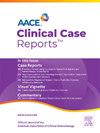Beyond Glucose Levels: Redefining Diabetic Ketoacidosis—A Case of Hypoglycemic Diabetic Ketoacidosis
IF 1.2
Q3 Medicine
引用次数: 0
Abstract
Background/Objective
Diabetic ketoacidosis (DKA) is a life-threatening condition typically diagnosed by the presence of hyperglycemia, acidemia, and ketonemia. A subset of patients may develop ketoacidosis without the traditionally increased glucose levels in a condition known as euglycemic DKA. This article describes an atypical presentation of DKA with concomitant hypoglycemia in a condition termed hypoglycemic DKA.
Case Report
A 74-year-old woman with a history of hypertension, type 2 diabetes mellitus (treated with empagliflozin), and hypothyroidism, presented from an outlying hospital due to concern for acute gallstone pancreatitis and choledocholithiasis. On arrival, laboratory evaluation revealed an anion gap of 16 mEq/L (reference range, 6-12 mEq/L), bicarbonate level of 11 mEq/L (reference range, 21-31 mEq/L), serum glucose level of 57 mg/dL (reference range, 70-105 mg/dL), beta-hydroxybutyrate level of 1.7 mmol/L (reference range, <0.6 mmol/L), and urinalysis demonstrating a ketone level of >80 mg/dL (reference range, <3.49 mg/dL). The patient was treated according to the institution DKA protocol, with resolution of her DKA.
Discussion
The case presented highlights a manifestation of DKA characterized by a concurrent state of hypoglycemia in a patient treated with a sodium-glucose cotransporter 2 inhibitor, an atypical and likely underreported phenomenon.
Conclusion
Clinicians should maintain a high level of suspicion for DKA in patients with metabolic acidosis and ketosis, irrespective of their glucose levels, in particular in those treated with sodium-glucose cotransporter 2 inhibitors. Additionally, redefining these cases as drug-induced ketoacidosis may assist in preventing delayed diagnosis and management.
超越葡萄糖水平:重新定义糖尿病酮症酸中毒-一例低血糖糖尿病酮症酸中毒
背景/目的糖尿病酮症酸中毒(DKA)是一种危及生命的疾病,通常通过高血糖、酸血症和酮血症来诊断。一部分患者可能会出现酮症酸中毒,而没有传统意义上的血糖水平升高,这种情况被称为血糖正常的DKA。这篇文章描述了一个非典型的DKA与低血糖合并的条件下称为低血糖DKA。病例报告:一名74岁女性,有高血压、2型糖尿病(用恩格列净治疗)和甲状腺功能减退病史,因急性胆石性胰腺炎和胆管结石症在边远医院就诊。到达时,实验室检查显示阴离子间隙为16 mEq/L(参考范围,6-12 mEq/L),碳酸氢盐水平为11 mEq/L(参考范围,21-31 mEq/L),血清葡萄糖水平为57 mg/dL(参考范围,70-105 mg/dL), β -羟基丁酸水平为1.7 mmol/L(参考范围,0.6 mmol/L),尿酮水平为80 mg/dL(参考范围,3.49 mg/dL)。患者按照机构DKA方案治疗,其DKA得到解决。本病例强调了在接受钠-葡萄糖共转运蛋白2抑制剂治疗的患者中以同时低血糖为特征的DKA表现,这是一种非典型且可能被低估的现象。结论:临床医生应对代谢性酸中毒和酮症患者的DKA保持高度警惕,无论其血糖水平如何,特别是那些接受钠-葡萄糖共转运蛋白2抑制剂治疗的患者。此外,将这些病例重新定义为药物性酮症酸中毒可能有助于防止延迟诊断和管理。
本文章由计算机程序翻译,如有差异,请以英文原文为准。
求助全文
约1分钟内获得全文
求助全文
来源期刊

AACE Clinical Case Reports
Medicine-Endocrinology, Diabetes and Metabolism
CiteScore
2.30
自引率
0.00%
发文量
61
审稿时长
55 days
 求助内容:
求助内容: 应助结果提醒方式:
应助结果提醒方式:


